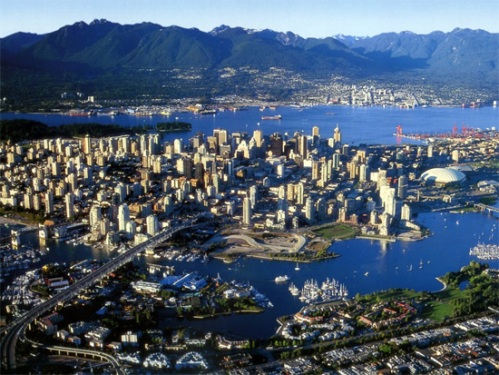 Put the village on hold. For the time being, it’s gonna take a parent, a councilman and a developer to raise a child.
Put the village on hold. For the time being, it’s gonna take a parent, a councilman and a developer to raise a child.
Flashback 2003: Attending the New Partners for Smart Growth conference in New Orleans, I caught the keynote from a planning official for Vancouver, British Columbia. Now, under normal circumstances, I don’t suppose I’d remember much of what he said but, at the time, my daughter was just over three years old and something he used as the overall framing for his making Smart Growth work presentation really resonated with me.
“If it works for kids,” he said, “it works for everyone.”
He went on with a series of slides showing a neighboring child from his downtown building taking to the streets, visiting a shop, playing in a tot lot. I remember being quite inspired by the idea and I imagine others were too, as it wasn’t too much later that “the popsicle test” — the ability of an 8 year old to safely get somewhere to buy a popsicle, then make it home before it melts — became the go-to elevator speech for a lot of New Urbanists making their case.
Now jump ahead to 2011. Just last week, in fact. Doing some work in Canada, I stumbled into a conversation on “the Vancouver model” — typically characterized by the pencil-thin towers that brought new density, and new life, to Vancouver’s revitalizing streetscapes — when something funny happened. “If you were to ask Larry Beasley (the city’s former planning director) today, in retrospect, what he sees as the biggest shortcoming of his legacy there,” someone said, “he would say it was the failure to bring kids downtown.”
WTH?

Downtown Vancouver. Photo credit: vancouver-bc-home-search.com/
The ultimate culprit, it was suggested, was that the model of development defining Vancouver in that era was most conducive to smaller unit types that were most appealing to the young, the single, the childless. Not families. I can’t speak to whether or not that’s accurate but it really doesn’t matter. [Ed. Note: Larry Beasley himself dropped by the Comments section below to say my cocktail party companion’s speculation was off base. He’s quite pleased with Vancouver’s results, as it relates to kids.] The larger point is this: Even in a place where attracting families was supported, even championed, by local leadership, it may have been easier said than done.
But that doesn’t make it any less critical.
Doing right by our kids is no small task. And we can’t do it alone. But perhaps we need to redefine exactly who it is we need — especially in the here and now — to help us through.
For too many years, we’ve tried to purchase our way to happiness for our kids and, quite responsively, the marketplace of products and ideas has made it all too easy. Surely a well cared for child shouldn’t have to share a bedroom, right? No problem, just move outside the city and get more house. Need a second income to pay for it? Again, no problem. There are plenty of daycare centers to fill in while you’re away. Afraid your older, unsupervised kids will spend aimless hours outside with nothing to do? Problem solved! The internet and all its associated tech gadgetry will keep them safely indoors with all the entertainment options anyone could ever want.
But what about their well-being, you ask? Fuhgeddabowdit! If you want them well-rounded, with opportunities to explore their interests, just pop open iCal and fill their calendar to your heart’s content. And if you find all the shuttling from place to place seems to steal the little remaining time a child would normally be playing, just swing by McDonald’s for lunch. They’ve got a PlayPlace there.
That may sound cynical, even unnecessarily snarky, but it’s also fair. The Atlantic this month describes college deans now dealing with these kids, whose every whim has been accommodated, every move scripted, every moment scheduled, every unpredictability or challenge sidestepped, and every decision made for them. Their term for them? “Teacups, because they’re so fragile that they break down anytime things don’t go their way.”
Maybe I’m in the minority, but that doesn’t sound like doing right by anybody. And I’m not the only one who feels that way.

Free-range kids at The Waters, outside Montgomery, Alabama.
But you can’t do it easily just anywhere. Place matters. It matters in the design of the streets and the things they connect to. It matters in the variety of uses, opportunities and activities. It even matters in the diversity of housing types. After all, smaller homes or accessory units end up housing people who appreciate, and want to be able to afford, the prospect of being a stay-at-home parent. Or seniors offering options for drop-off babysitting. Not because it’s their corporate value proposition and you’re paying them a thousand bucks a month but because they’re your neighbors and they care about you.

Place matters: The Market, a community gathering spot at The Waters,
a new urban community just outside Montgomery, Alabama.
Now here’s the rub: There’s only so many neighborhoods that offer this type of environment and, more often than not, they’re historic. That means, on the lower end, that they often come with crime, poor schools and disinvestment issues or, on the upper end, are cost prohibitive for everyday, middle class families.
There’s just not enough good ones to affordably meet a demand which, as talk of teacups finally brings down the era of helicopter parents, will only grow over time.
That brings us back to where this post began. Talk of how it takes a village to raise a child sounds — and feels — good but, to make it work, you need a village to start with. Which means you need politicos willing to push it, and developers willing to build it.
Want to do right by your kids? Then cuddle up with your councilperson until they see the value of compact, mixed-use, walkable, kid-friendly neighborhoods and bake a plate of cookies for the first developer who shows up to build it.
–Scott Doyon

The city, town or village is not a bad place to raise a child: Exhibit A.










Pingback: re:place Magazine
A persuasive piece (not that I need persuading). I’d like to have seen at least a nod to some of the key writing and thinking on children, cities & liveability. In my own work, I find myself returning to Jane Jacobs in The Death & Life of Great American Cities. And the modernist architect Aldo van Eyck in post-war Amsterdam, superbly curated in the book “Aldo van Eyck: The Playgrounds and the City” edited by Ingeborg de Roode & Liane Lefaivre. (Read a terrific review by British urbanist Ken Worpole here:
http://ads.opendemocracy.net/arts/playgrounds_3260.jsp)
And Kevin Lynch and a few torch-bearers of his Growing up in Cities programme in the last few decades. I could go on, but instead I’ll close by mentioning Children & their Urban Environment by Claire Freeman & Paul Tranter & , which is a fine recent survey.
Thanks, Tim. All good, important references worthy of note. To be honest, I think the omission was largely due to the fact that I was coming to the subject through the lens of my own work. The article in the Atlantic is what, especially as a parent who wants to do good rather than just feel good, resonated with me the most. Once I began thinking about the physical environment and how it could help offset the negative effects producing these “teacup” children, I began to view it in terms of obstacles standing in the way. Most notably, the lack of political support for change and the resistance of people to development, even when it’s development that supports their goals.
I guess the least surprising revelation is that rearing children of character and substance is no small feat. It’s a poignant reminder. Thanks for the supporting content.
The International Making Cities Livable conference, headed by Suzanne Crowhurst Lennard, is a strong advocate of child-friendly cities, on the same lines of thought you identify here. Worth a check out. http://www.livablecities.org
Good stuff. Especially the pictures!
See also: http://newurbanmom.com/
Before planners, designers and local Gov will consider children’s needs in their environments, they need to first recognise their own responsibilities in the process- a difficult task with professionals who rarely see children in their working lives.
That’s why we at Play England developed the Play Shaper training, a 1 day intensive graduate level professional development seminar for planners, transport mangers, landscape designers, police, health, education and local politicians – the full set of those responsible for children’s spaces and time outside of the family. Responses on the day and the full evaluation of the programme (on our website) show how huge an impact this day had for delegates, informing their practice for months to come.
Health and safety planners realised their role in encouraging children to build the safety skills to move around their own neighbourhoods. Police built partnerships with youth services and committed to playing football with young people instead of moving them away from playgrounds. Health leads built active play into obesity and safeguarding strategies. Education professionals looked to parks for outdoor learning. local authorities and councillors saw play as a perfect tool and topic for local consultation and engagement.
We’re now talking to a University about revisiting the evaluation a year on.
Funding has finished now, but we are beginning to work with some individual local authorities and national organisations on tailoring this accredited (& copyrighted!) training to their needs, and to develop mini versions for local communities. Do get in touch if you’d like to know more.
http://www.playengland.org.uk/our-work/play-shaper
Pingback: City boosts funding for new playgrounds. Enough? | Edmonton Journal
Pingback: Quora
Pingback: 21c3 | Test a Neighborhood's Livability with the "Popsicle Test" and the "Halloween Test"
Pingback: How to Lower Housing Prices
I lived in Vancouver Canada during the 90/2000’s and there was a LOT of talk about new urbanism, compact/ECO communities, MIXED use areas ETC BUT the developers used it as an excuse to build VERY small 1 Bead room Apts and MILLION dollar townhouses with NO outside space at all beyond a deck,
fallow the news in VANCOUVER/BURNABY and the schools are closing where as out in Surrey/Abbotford (commuter towns from vancouver) they are opening up NEW schools
Pingback: The Popsicle and Halloween Tests: What Makes a Place Livable? « UrbanVista
Couldn’t agree more. It’s really hard to find an affordable 3-bedroom rental apt. or condo in downtown Ottawa. Our apt. building has a lot of young couples who move out shortly after having their 1st kid, and they’re leaving downtown for a suburban house. There are 1-bed & 2-bed apts downtown, and then there are super-expensive 4+bed penthouses. Evidently developers can get more money per sq ft by maximising the number of small apts than by including some family apts in the mix.
Ironically, there is a quickie mart across the street with popsicles aplenty.
Scott,
Your post was passed along to me, which I found fascinating since I’m the ‘planning official’ you referenced. (Actually I was a City Councillor from 1986 to 2002 in Vancouver.)
I thought I’d respond in more detail on my blog – http://pricetags.wordpress.com/2011/08/26/placemaking-the-kid-question/ – which also contains a link to a more detailed post-occupancy evaluation of one of the megaprojects constructed in Vancouver.
While I don’t think it’s fair to say that our high-density developments were a failure at attracting kids – and I’d be surprised if Larry Beasley meant that – there are definitely problems of affordability, design and supply, all of which are addressed in the study.
Nonetheless, Vancouver continues its commitment to family-friendly neighbourhoods in all forms.
Thanks for the opportunity to continue the discussion.
Gord Price,
Director of the SFU City Progam – http://www.sfu.ca/city
Thanks, Gord. How I love the internet for real-time clarification.
As mentioned, I really enjoyed your keynote at the time and have carried many of its lessons — in terms of both aspirations and challenges — forward over the years. Its premise seemed so logical that, when confronted many years later with people suggesting it didn’t pan out as well as intended, I was genuinely surprised. Glad to hear there are in fact a lot of positive achievements to be noted.
My real point, and one I’m glad you picked up on rather than jumping to the assumption I was dogging Vancouver (which I most certainly was not), was that, even when you’ve got great, committed leadership pushing the issue, attracting families with kids downtown (any town) remains a tough, but critical, road to travel.
It’s an ongoing battle. Glad to hear that Vancouver’s still fighting it. One step at a time.
Best,
Scott
Hello Scot,
Larry Beasley here. Whomever you were talking too completely misquoted me. In fact, while there may be a lot to be critical about the “living first” strategy for Downtown Vancouver that I led to fruition in the 90’s, the policy to entice families with children is NOT a place for criticism. In fact, it was one of our most successful policies and it shows that a solid and well articulated policy commitment by local government can work, even at very high densities. Just recently the City (I am now retired from government there), did a survey that revealed that fully 25% of Downtown households have children, and also revealed that they are of all ages. Interestingly enough, that was exactly our target in the 1991 Downtown Plan. Michael Gordon of the City of Vancouver told me about the study, although I have not read it in detail. Also, in my capacity as a professor at the University of British Columbia School of Community and Regional Planning, with another professor, Dr. Windy Sarkissian and about 15 students, several years ago we completed a post occupancy evaluation of the major new neighbourhood in Downtown, False Creek North, and found that families with children were happily in residence, although they have issues that need attention, similar to those you would discover even in suburban neighbourhoods. By the way, it also found that 91% of people we surveyed were “happy” or “very happy” with their homes and life in the neighbourhood, even though it is the densest neighbourhood in the city. Everywhere in the world that I work and speak, I tell that Vancouver story and I offer the details of the policy framework for that success. You see, for me, strong advocacy for families with children in ALL communities has been a lifelong passion. I am very satisfied that we achieved a good mix in the new communities that we planned and build in Vancouver after 1986.
The biggest thing to be critical about for Vancouver is overall housing affordability. Currently this is a huge issue for our city (and for almost all successful cities around the world) and Vancouver’s as well as Canada’s current governments are not doing enough to address the problem.
Best regards.
Larry
Thanks, Larry. Very glad to hear the positive results, though I’m sure you’d agree they took considerable work. As I mentioned in the post, whether the cocktail chatter I stumbled into was accurate or not was really secondary to a larger point: Trying to do what you (and Vancouver) did is hard.
But worth it.
One additional note: I wouldn’t so much say that someone misquoted you, as they weren’t suggesting you *did* say it; they were speculating you *would* say it. However, your comment here obviously makes clear otherwise, so I’ll amend the post to clarify.
Thanks for the additional info!
Pingback: Popsicles and the Importance of Simplicity |
Pingback: The Popsicle and Halloween Tests: What Makes a Place Livable?
Pingback: A Good Neighborhood, Simply « Laurel Park Management
Pingback: The Popsicle and Halloween Tests: What Makes a Place Livable? | urbanvista.net
Pingback: Smart Growth = Smart Parenting, Part Two | PlaceShakers and NewsMakers
Pingback: Life as I’d Like It To Be | PlaceShakers and NewsMakers
Pingback: The Popsicle Test « Jen's Blog
Pingback: The Popsicle Test « We Heart OTR
Pingback: The Popsicle Test | (pro(vo)cation)
Pingback: 200,000: What’s in a number? | PlaceShakers and NewsMakers
Pingback: Free Range Kids » Passing the Popsicle Test